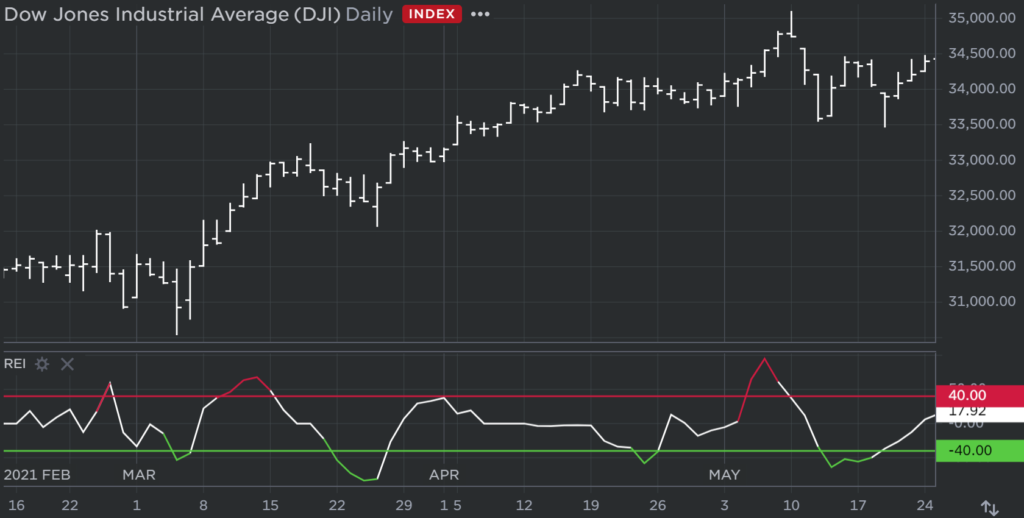Several problems are associated with standard oscillators. One concern is the fact that formulas usually compare price action over consecutive days. This can lead to large swings in the oscillator as prices react to news. Another concern is that most oscillators rely on closing prices. Other time period relationships are also important.
TD Range Expansion Index® was designed to avoid these concerns. It also avoids other pitfalls associated with some of the most popular oscillators.
Specifically, it compares true high and low prices over a defined lookback period. By default, it compares today’s prices to the prices two days ago. It also compares the current price to the price up to eight days ago.
One potential benefit of REI is that after a trend forms, REI allows a trader to participate in the trend. Traditional oscillators often produce premature overbought or oversold indications that force traders out of positions too soon.
What is REI?
REI is an arithmetically calculated oscillator. Many popular oscillators use exponential calculations. Exponential formulas overweight recent data. Because of that, large fluctuations and rapid reversals in the indicator’s trend are more likely.
Its formula consists of five independent steps. These steps are shown in the calculation selection below.
This chart shows REI at the bottom. It is calculated with the default setting in Symbolik® by DeMark®.

REI is a simple indicator. It is not a complete trading strategy. REI should always be combined with other indicators to develop trading strategies. Traders should also consider different levels of parameters in REI. Small changes can increase or decrease trading frequency and change the possible risks and rewards of trades.
In addition, TD Price Oscillator Qualifier® rules REI entry levels should always confirm REI.
How do I use REI?
REI can be used to identify potentially overbought or oversold markets. Unlike typical oscillators, REI does not give trading signals by simply crossing overbought or oversold levels. For REI, moves to extremes are just the first step in evaluation.
When extreme readings are recorded, either oversold or overbought, it is prudent to wait for a return to neutral and then a subsequent return to oversold or overbought. After that, a price reversal can be expected, provided the reading is mild or modest.
In addition, traders should consider the amount of time REI spends at overbought or oversold extremes. This is a concept DeMark calls duration analysis.
Periods when REI is overbought or oversold for six or fewer price bars are mild. Duration analysis involves time, not the level of the indicator. If REI reached a value of 100 for four consecutive days, for example, that is still a mild overbought reading.
When REI remains overbought or oversold for more than six price bars, it is likely the trend is strong.
This is contrary to what many investors believe. It’s not necessarily true that markets are most susceptible to reversals when in extreme overbought/oversold territory. DeMark has found reversals are more likely to occur from mildly overbought/oversold levels.
Ideally, extreme momentum readings should revert to neutral levels and then correct back toward mildly overbought or oversold territory before a meaningful reversal can begin.
Where can I learn more?
Symbolik Education and Training:
https://demarkhelp.zendesk.com/hc/en-us/categories/360003606693-Education-and-Training
Books including The New Science of Technical Analysis by Thomas DeMark; New Market Timing Techniques by Thomas DeMark; and DeMark On Day Trading Options by Thomas DeMark and Thomas DeMark, Jr.

